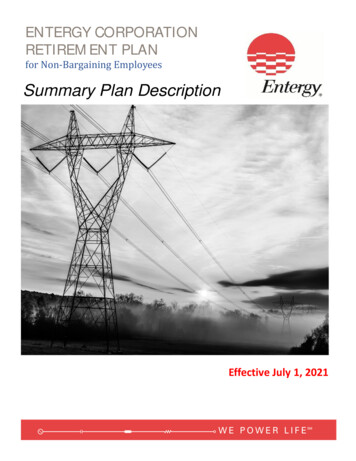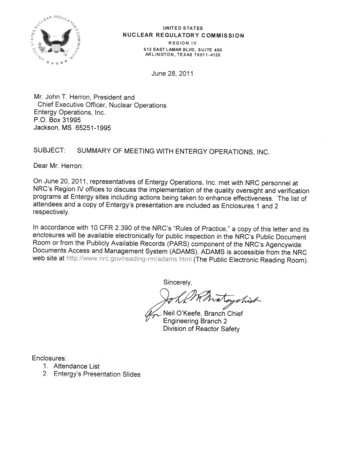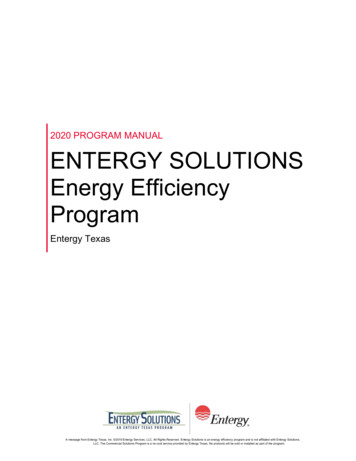
Transcription
Entergy Texas, IncR E Q U E S T F O R S O L A R P H O T O V O LTA I CRESOURCESBIDDERS CONFERENCEJ U LY 2 8 , 2 0 2 1Creating sustainable v alue for allPage 1
Introductionv Conference Purpose To give participants a high-level overview of the 2021 Entergy Texas, Inc. ("ETI") Request for Proposals ("RFP") forSolar Photovoltaic Resources (“2021 ETI Solar RFP”) and related processesv Questions Please submit all questions to the Bid Event Coordinator via email at etirfp@entergy.com (to ensure that ETI has anaccurate record of each question posted) Please refrain from including bidder-specific or confidential information in the question This presentation, along with RFP questions and responses, will be posted to the 2021 ETI Solar RFP 2021ETIRenewablesRFP/Index.htm To the extent ETI’s posted responses differ from the verbal responses given during the conferences, the writtenresponse will controlv Administrative In the event of an inconsistency between the presentation and the RFP documents, the RFP documents will control All phones must be on mute Please do not place your phone on hold Email the Bid Event Coordinator at etirfp@entergy.com with any technical issues or questions concerningparticipation in the Bidders ConferencePage 2
AgendaIntroductionsRFP Overview & ScopeRFP Evaluation ProcessProcess SafeguardsQ&A Review SessionPage 3
IntroductionsEntergy PresentersStaci MeyerMarc SawickiRyan ScottDaniel BoratkoBrian SullivanDavid BattenEric AganaAdditional Entergy ParticipantsETI Resource Planning TeamRFP Administration TeamViability Assessment TeamEconomic Evaluation TeamTransmission Evaluation TeamAccounting Evaluation TeamCredit Evaluation TeamJames MillerCarl OlsonMisty HarrisPhong NguyenSaundra BradleyESL Assistant General CounselETI Regulatory ManagerRFP Administration TeamRFP Administration TeamETI Resource Planning TeamIndependent MonitorKeith OliverWayne OliverMerrimack Energy Group, Inc.Merrimack Energy Group, Inc.Page 4
RFP Overview and ScopeStaci MeyerPage 5
2021 ETI Solar RFP Overview: Rationale for RFPFour overarching considerations drive the need to proceed with the development of utility-scalesolar resourcesCapacity and Energy NeedsSupply DiversificationRenewable EconomicsTiming of NeedsPage 6
2021 ETI Solar RFP ScopeSeeking 400 MWof solar resourcesResource sizerequirements Battery and O&Moptions accepted Max: 200 MW Min: 50 MWBOT, Self-buildand PPAstructuresLocated in Texasregion of MISOSouthIn-Service byJanuary 2, 2025Executed GIA orin the 2021 MISODPP or earlierstudyPage 7
Location of Texas Region of MISO SouthPage 8
RFP Schedule & EvaluationProcessMarc SawickiPage 9
2021 ETI Solar RFP Targeted TimelineTentative Schedule Overview20232022202120242025Approval of RFPSelections byJan 2022RFPDevelop.ProposalDevelop. 6 months 3 months J an ‘21 – J uly ‘21J u l y ‘ 2 1 – Oc t ‘ 2 1RFPEvaluation 3 months Oct ‘21 – Jan ‘22Negotiation / InternalApprovals 5 months J an ‘22 – J un ‘22Regulatory Process (Includespreparation) 14 monthsJun ‘22- Q3 ‘23Engineer, Procure, ConstructionCODJan ‘25 QQ3 ‘23 – Jan ‘25MISO DPP Process (Current MISO Schedule) 1.5 yearsJuly 2021 – March 2023Page 10
2021 ETI Solar RFP Timing OverviewKey MilestonesMilestoneCompletion DateRFP Documents PostedJuly 15, 2021Bidders ConferenceJuly 28, 2021Bidder Registration Period (8/27-9/3)September 3, 2021*Proposal Submission Fee Payment DeadlineSeptember 15, 2021*Self-Build Proposal Submission DeadlineOctober 8, 2021*Proposal Submission DeadlineOctober 15, 2021*Notice to Bidders of Primary and Secondary SelectionsJanuary 18, 2022*Comprehensive ETI Due Diligence and Definitive Agreement Negotiations BeginJanuary 19, 2022*Bidder(s) Remaining on Secondary Selection List Released from ProposalsApril 18, 2022*Definitive Agreements ExecutedJune 9, 2022*Regulatory Approval Process CompleteAugust 3, 2023*Project CompleteJanuary 2, 2025**The milestone dates accompanied by an asterisk are target dates, which are subject to change.Page 11
Bidder Registration & Proposal Submissionv Bidder registration and proposal submission will utilize forms and templates posted to 2021 ETI Solar RFP Website Bidder Registration Form PowerAdvocate Proposal Package includes, but is not limited to: Proposal Submission Template Due diligence questionnaire(s) “Appendix D”, and related attachments Self-Assessment Form Proposal Submission Agreement Redlining of Applicable Model Agreement (BOT & Scope Book, PPA, and O&M Agreement as necessary)v All proposal-related document submissions must be made via PowerAdvocate Executed Proposal Submission Agreement Complete responses to Proposal Submission Template and diligence requests Proposals not delivered through PowerAdvocate will not be acceptedv Email will be sent to bidder confirming receipt of documentsPage 12
Bidder Registration & Proposal Submissionv Proposal Submission Fees 10,000 for each registered proposal (Solar PV) Any alternative COD, price, location, or other significant feature (excluding battery and O&M options) of aproposal will trigger an additional bid fee of 10,000 Bidders offering a proposal that includes a battery or O&M proposal(s) will be required to pay an incrementalcharge of 1,000 for each battery or O&M proposal Bidder will be invoiced proposal submission fee(s) within three business days after the end of the Bidder RegistrationPeriod ETI must receive payment of the proposal submission fee for each registered proposal no later than 5:00 p.m. CPTon September 15, 2021 (current schedule) If Bidder misses the payment deadline for a proposal, the proposal may be subject to eliminationPage 13
RFP Evaluation Processv The evaluation process is designed to be fair, impartial, and consistently applied Prior to submitting proposals, Bidders will receive sufficient information to understand the evaluation factors andgeneral decision criteria Detailed inputs and evaluation scenarios will be considered confidential and highly proprietary and will not be sharedwith potential bidders or the self-build team To the extent practical, evaluation models and assumptions will be defined before proposals are receivedv Proposals will be reviewed and assessed for the following: Economics (Net Supply Cost) Interconnection/Deliverability/Transmission Viability Credit and Collateral Requirements Accounting Treatmentv Assessments will occur in the following stages: Phase I Initial Threshold Determination Preliminary Shortlist (if applicable) Phase II Detailed Qualitative & Quantitative AssessmentsPage 14
Redaction & Initial Threshold DeterminationRedactionv The purpose of the redaction process is to ensure that: Evaluation teams receive information relevant to their respective areas Bidder name and identifying criteria are redacted from the information provided to the Economic Evaluation Team Bid price is removed from the information provided to the Viability Assessment Team and the Transmission Evaluation Team (other thanspecified price approved by the RFP Administration Team that is needed)v The RFP Administration Team will open and redact all proposalsInitial Threshold Determinationsv Initial threshold determinations will occur early in the proposal review processv The purpose of these determinations is to identify proposals that meet certain minimum threshold requirements for participation inthe RFPv Proposals not meeting threshold requirements will be subject to eliminationv Threshold requirements include, but are not limited to, those concerning: Eligible Participants Resource Location Eligible Technology Minimum and Maximum Capacity Proposal Requirements Eligible Transactions PPA Delivery Terms (Min 10 Years, Max 20 Years) Eligible ResourcesPage 15
Phase I & Phase II Evaluationsv Phase I Evaluation will include evaluations primarily by Economic Evaluation Team Viability Assessment Team Transmission Evaluation Team Credit Evaluation Teamv The purpose of the Phase I evaluation is to identify the most economic proposals and to eliminate: Proposals not meeting the RFP's threshold requirements Less economic proposals Proposals determined to be unacceptably high riskv The purpose of the Phase II evaluation is to evaluate the short-listed proposals in greater detail and develop finalrankings and conclusionsv The output of Phase II will be a Final Reportv The Final Report will be sent to ETI, which will make proposal selectionsPage 16
Selectionv Primary Selection List Bidder(s) with a proposal on the primary selection list will be invited to negotiate a definitive agreement A proposal’s inclusion on the primary selection list is not acceptance of the proposal or related contract terms No requirement for ETI to place any proposal on the primary selection listv Secondary Selection List Bidder(s) with a proposal on the secondary selection list may be invited to negotiate the terms of a definitiveagreement or may be advised of proposal status Bidder(s) would proceed to definitive agreement negotiations only if a Bidder(s) on the primary selection list isremoved from list Bidder(s) must hold offers open for three months after notification of secondary selectionPage 17
Commercial TermsRyan ScottPage 18
Commercial Terms Overviewv Model contracts are included in the RFP In proposals, Bidders may propose exceptions to terms ETI is under no obligation to agree to any exception Significant requested changes could affect viability ratings or eligibilityv BOT Structure Seller will own, develop, design, build, commission, test, and commit to sell the proposed project to ETI at a fixedprice This hybrid transaction incorporates EPC principles and generation asset acquisition termsv PPA Structure ETI will be entitled to all energy, environmental attributes, capacity, capacity-related benefits, and other electricproducts from the proposed project Energy will be scheduled by Seller to ETI’s Load Node in MISOv Interconnection Seller will be responsible for (and required to account for in its proposal(s)), ALL costs and schedule risksassociated with transmission and interconnection of the proposed resourcev Credit Support Seller will be required to provide liquid credit support, in the form of an acceptable letter of credit or cash Bidders are encouraged to review thoroughly Appendix F to the 2021 ETI Solar RFPPage 19
Commercial Terms Overview – BOTAgreementStructurePurchase Price Bidders will develop, design, construct, and test according to requirements in the BOT Agreement (App B-1) and the technical requirements of theScope Book (App B-2) ETI will purchase the asset at Closing (after mechanical completion and prior to facility energization), at which point title and risk of loss transfer toETI; project care, custody, and control will remain with Seller through the Substantial Completion Payment Date Bidders are required to provide an all-in purchase price Purchase price will be paid only at the Closing, Substantial Completion, and Final Completion; no progress payments will be madeSubstantialCompletion Guaranteed Substantial Completion Date Required to be no later than January 2, 2025; the contract includes provisions on delay damages, forcemajeure extensions, capacity re-sizing or buy-down, and ETI termination rights for extended completion delays Guaranteed Substantial Completion may be adjusted back with a reduction in total Force Majeure days allowed Testing requirements include availability, capacity, BESS, energy yield.ITC and In-ServiceRequirements Bidder generally will bear risk of loss related to ITC benefits due to schedule delays Modified contract terms will apply to projects that start construction for ITC purposes in 2019 and 2020 (e.g., earlier GSCD, lost ITC LDs, potentialincremental credit support)Project Warranties Seller not required to provide a “wrap” warranty At the Closing, all warranties will transfer to ETI, including the project warranty from the prime EPC Contractor(s) EPC-related contracts will not transferPage 20
Commercial Terms Overview - PPAAgreementStructureCOD and DeliveryRequirements ETI will receive all energy, capacity benefits, other electric products, and environmental attributes from the resource ETI will pay for delivered energy only, fixed or variable pricing, no indexing COD requirements – Linked to delay damages, capacity re-sizing, termination right for long delays ITC - Resource must be placed in-service no later than January 2, 2025; Bidder wears ITC risk Annual Guaranteed Energy Quantities (AGEQ) - LDs assessed for delivery below AGEQ (P90), 50% price for delivery over115% of AEEQ (P50); annual shortfall termination rightsFinancialSettlement PPAs will be required to settle financially at the ETI Load Node Sellers will be responsible for imbalance charges, including transaction fees, scheduling charges, revenue sufficiencycharges, integration fees, etc. ETI will not accept negative price riskAccountingTreatment The PPA may not result in the recognition of long-term liabilities to ETI’s balance sheet, including lease treatment,derivative accounting, or VIE (variable interest entity) liabilitiesRegulatoryDisallowance Sellers will be required to absorb the risks of regulatory disallowance (e.g., disallowance of replacement energy costs),excluding certain limited cost recovery risks that remain with ETI (e.g., disallowance due to active buyer fault)Page 21
Updated Commercial TermsReliability Requirements It is key for PPA resources to be reliable and resilient as they become an increasing part ofETI’s portfolio Recent large-scale weather events, including the 2020 hurricane season and Winter Storm Uri,demonstrate the importance of ensuring ETI’s sustainable resource additions are reliable and resilient ETI and its customers expect ETI will obtain reliable, low cost, renewable power supplies in this andsubsequent resource procurements Attachment B-1 to the Model PPA lists reliability requirements for PPA resources participatingin the RFP They include design and equipment sourcing requirements intended to help protect the facilities andcustomers from risk associated with wind, hail, flood, fire, and freezing conditions The list is a measured set of requirements taken from select portions of the BOT Scope Book (and thusalso apply to BOT resources participating in the RFP) PPA bidders are encouraged to review the list and related contract termsPage 22
Viability AssessmentRyan ScottPage 23
Viability AssessmentvThe Viability Assessment Team (VAT) includes subject matter experts from the following focus areas: CommercialEnvironmentalInsurance and Risk EngineeringInvestment Tax Credits (ITC)Operations and Maintenance (O&M)Plant & EquipmentReal EstateOther disciplines, as appropriatevThe VAT’s key objectives are to: Perform a review and assessment of the non-price attributes of the proposals The review will be based on information bidders provided in response to the RFP and include the due diligencequestionnaires, proposal summary, and clarifying questionsvTwo-phased analysis Phase I: A minimum requirements review for each proposal and an equivalent standard validation across all proposals Phase II: An assessment of the individual projects on the risk associated with key aspects, including, but not limited to,bidder experience, technological specifications, site environmental conditions, real estate terms and requirements, andexceptions to the terms of the agreementPage 24
Viability Assessment – Phase IvPhase I will consist of an initial VAT assessment that includes confirmation of Bidder-provided selfassessments, such as the following: Proposal is for an eligible technology by an eligible participant from an eligible resource Proposal meets MW minimums & maximums and delivery term requirements Proposal is for years for which ETI is seeking resources in the RFP Resource meets the appropriate design and operating specifications Resource is free of fatal flaws and operational or permitting restrictions Proposal aligns with all RFP requirements, including Threshold Requirements§Self-assessment is required for each proposalvThe VAT will confirm to each of the other evaluation teams that a Bidder’s proposal meets the thresholds (ornotify them of discrepancies)Page 25
Viability Assessment – Phase IIvvDuring Phase II, the VAT will provide a more detailed evaluation and assessmentThe Phase II VAT assessment will include: Evaluating a key list of attributes associated with each of the focus areas identified for the viability assessment Also confirming the Bidder information provided is reasonable and credible, including operating parameters,deliverability, project timeline, and permit feasibility The attributes will be assessed in a pre-defined detailed scorecard, ultimately leading to a total viability rating for eachproposal (High Risk, Medium Risk, Low Risk, etc.)Page 26
Economic EvaluationDaniel BoratkoPage 27
Economic EvaluationvvvThe Economic Evaluation Team (EET) will conduct an economic evaluation of proposals from the perspective ofETI’s customersThe economic evaluation will identify proposals that meet the RFP requirements and rank them based on relativeeconomicsThe EET will utilize tools and methods ETI commonly uses for long-term planning and resource evaluations,including: Variable supply cost analysis within the context of the MISO markets based on simulations using the Aurora productioncost modeling software Pricing based on proposal submissions and responses to clarifying questions issued to bidders Estimated property tax expense, considering obtained or identified property tax abatements or similar tax benefits, ifapplicable Transmission cost estimates, if applicable, from the TET for expected required projects Long-term avoided capacity value Alternative structures, such as a tax equity partnership Terminal value, if applicable Lease accounting treatment, if applicable Imputed debt, if applicable Any other applicable economic benefits, taxes, or costs Include qualitative risk considerations and sensitivity analysis (e.g., scenarios around natural gas and carbon prices) ifneeded Other tools and methods if and as required or appropriate for the economic evaluation of a proposalPage 28
Economic Evaluation ProcessvA net cost / benefit calculation will be performed for each proposalvThe net cost / benefit will be presented in M, levelized real /kW-year, and levelized real /MWh to account fordifferences in proposal size and expected energy productionIllustrativeNotes:*Proposal Fixed Costs, Transmission Costs, and Other Costs will be included as part of the all-in energy pricing provided for PPA proposals.Page 29
Transmission EvaluationBrian SullivanPage 30
Transmission Evaluation TeamvThe Transmission Evaluation Team’s (TET) evaluation objective is to:———vEnsure that with the addition of any resource, adequate area reliability is maintainedIdentify any upgrades associated with maintaining adequate reliabilityAssess costs of all transmission infrastructure-related improvements required to incorporate each studied resourceInterconnection requirements and deliverability———Bidder will be responsible for and bear all costs associated with the proposed facility’s electric interconnection to the gridInterconnection costs should be included in Bidder’s proposed pricingBidders need to identify separately the estimated interconnection costs ———A proposal that omits these costs or takes “special exception” to this requirement will be considered non-conforming and may beeliminated on that basisBidder’s facility must have an existing GIA or be included and remain in the 2019, 2020 or 2021 MISO DPP QueuesResource must be located within the Texas Region of MISO South and interconnect to the MISO South transmissionsystemResource must remain in the interconnection queue until the resource is eliminated or interconnection service is obtainedPage 31
Transmission Evaluation TeamvThe Transmission Evaluation Team will perform standard analyses to ensure each proposal does not negativelyimpact the reliability of the transmission systemvAnalysis may include, but is not limited to: NRIS deliverability analysis ERIS deliverability analysis Standard steady state power flow analysis to identify potential projects based on ESL's annual TPL-001-4 analysis andESL's Local Planning Guidelines and Criteria Transient Stability, Voltage Stability, and Short Circuit analyses per TPL-001-4 and ESL's Local Planning Guidelines andCriteria Cost estimating and scheduling analysis for interconnection and transmission facilities Fault Induced Delayed Voltage Recovery (FIDVR) analysisPage 32
Accounting EvaluationDavid BattenPage 33
Accounting EvaluationvvThe Accounting Evaluation Team (AET) will assess potential accounting effects of PPA proposals, including: Whether the proposal contains a lease resulting in the recognition of a long-term liability for ETI or its affiliates under therules in effect during the term of the proposal (ASC 842 analysis) Whether the legal entity owning the proposed generating asset is a variable interest entity (“VIE”) and, if so, who willconsolidate the VIE throughout the term of the agreement (ASC 810 analysis) Whether the proposal is or includes a derivative and, if so, the appropriate accounting for the derivative (ASC 815analysis) Other accounting impacts from the proposalThe Accounting RFP requirements include: ETI will not accept proposals that result in the recognition of a long-term liability by ETI or its affiliates (“on-balance sheetaccounting”) If requested, Bidder will certify that it has determined that, to the best of its knowledge, the proposed PPA will not requireon-balance sheet accounting for ETI or its affiliates Bidder will be required to make available all information required to verify and/or independently determine the accountingtreatment associated with a proposalETI will not accept the risk of any transfer to its books of any long-term liabilityassociated with a PPA arising out of the RFPPage 34
Credit EvaluationEric AganaPage 35
Credit EvaluationvThe Credit Evaluation Team (CET) will evaluate Bidder’s credit and other credit-related mattersvInformation to be provided at bidder registration: Bidder may elect to nominate a parent guarantor for consideration for liquid credit support offset; limited to one nominee Public credit ratings, if available, for Bidder and, if applicable, the proposed parent guarantor Financial statements for Bidder and, if applicable, the proposed parent guarantorvThe Credit RFP requirements include: Specific liquid credit support amounts, available parent guaranty-based offsets to liquid credit postings, and credit events(which can eliminate credit offsets) are set out in the credit appendix to the RFP (Appendix F) Forms of acceptable incremental credit support are letters of credit from qualified banks and cash holdbacks Special exceptions to core credit terms are not permitted Bidder must submit with its proposal(s) a credit compliance certification acknowledging its familiarity with the terms of thecredit appendix and certifying that the proposal(s) (including proposal pricing) reflect and comply with credit appendixrequirementsPage 36
Credit EvaluationvTwo-phased process for credit evaluationsvDuring Phase I, CET will assess bidder and, if applicable, proposed parent guarantor for a potential offset to theliquid credit support requirements The CET will assign a Bidder credit rating (or Bidder’s parent guarantor credit rating) based on, among other thingsoS&P and Moody’s ratingso10K/10Q/8K evaluationoIf SEC reports unavailable, two years of audited financial statements provided by Bidder Financial statements include balance sheet, income statement, cash flow statement, notes to the financials, asshould include the auditor’s opinion If financial information is consolidated with other entities, all data related solely to the offering entity will beextracted and submitted as separate documents by Bidder Credit-related diligence materials provided by Bidder vThe CET will provide Bidder with details regarding the liquid credit support offset prior to proposal submissionDuring Phase II, CET will review each proposal to determine the credit support amount required for each milestonePage 37
Process SafeguardsMarc SawickiPage 38
Process SafeguardsCode of Conduct, Protocols, Design, Stakeholder ParticipationCode of Conduct All employees of ESL, any Entergy Operating Company, or any Entergy Competitive Affiliate must adhere to the applicable Affiliate Rules andCodes of Conduct Links are provided on the 2021 ETI Solar RFP websiteAdditional Protocols Each 2021 ETI Solar RFP Proposal Evaluation Team is made up of designated personnel Team composition is overseen by the IM ESL personnel involved with the 2021 ETI Solar RFP evaluation process will adhere to the provisions of a confidentiality acknowledgement thatgoverns access to and use of information contained in proposals and proposal related documents Additional protocols will be specified in the 2021 ETI Solar RFPRFP Process Design and Implementation RFP process has been designed to assure fair and impartial treatment of all Bidders Self-build proposal will be finalized and “locked down” with oversight from the IM prior to the receipt of third-party bidsStakeholder Participation The RFP will be posted on ESL’s public 2021 ETI Solar RFP website and is publicized to encourage robust market participation Bidder Conference Potential Bidders will be provided opportunities to ask questions about the RFP and seek clarification on the RFP processPage 39
Q&A SessionETI requests that Bidders submit all questionsto the Bid Event Coordinator at etirfp@entergy.comPage 40
Entergy Texas, Inc R E Q U E S T F O R S O L A R P H O T O V O LTA I C R E S O U R C E S B I D D E R S C O N F E R E N C E J U LY 2 8 , 2 0 2 1. Page 2 Introduction v Conference Purpose To give participants a high-level overview of the 2021 Entergy Texas, Inc. ("ETI") Request for Proposals ("RFP") for










